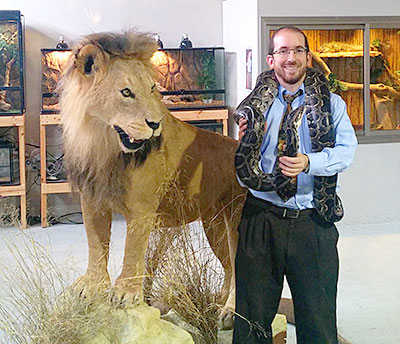Rabbi Natan Slifkin began his life-long passion for animals when he was a small child. His keen interest has never diminished. In fact, at age 40 it has intensified. Today, he is known as the “zoo rabbi.”

Rabbi Slifkin shows off skulls of animals that lived in Biblical times.
Now completing his PhD at Bar-Ilan University, Rabbi Slifkin is putting the finishing touches on his dissertation “Rabbinic Encounters with Zoology in the 19th Century.” A native of Manchester, England who made Aliyah 23 years ago, Rabbi Slifkin just published the first volume of The Torah Encyclopedia of the Animal Kingdom, and this past fall he opened the Biblical Museum of Natural History in Beit Shemesh (www.BiblicalNaturalHistory.org).
The museum showcases the mammals, birds, reptiles, amphibians and insects of Scripture, as well as related zoological topics from the Talmud. Larger biblical animals are displayed as taxidermy exhibits while the smaller creatures are live specimens. Visits (which must be arranged in advance) are conducted via guided tours in either English or Hebrew, and enable people to experience a unique aspect of the Bible.
Clarifying the Identity of Biblical Animals
In his recent visit to the New York offices of the American Friends of Bar-Ilan University, Rabbi Slifkin explained how his academic studies assisted with both the museum and the encyclopedia, especially in terms of identifying biblical animals. “The academic approach sheds light upon traditional scholarship by examining the surrounding context,” he said. This clarifies why there are sometimes discrepancies between how an animal is described in the Bible and Talmud as opposed to how Europeans identified these animals.

At his Biblical Museum of Natural History, Rabbi Slifkin shows off one of his large stuffed mammals and live snakes.
“The Bible and Talmud describe animals as they appeared in Israel, which was a handicap for pre-19th century rabbinic scholars in Europe,” explains Rabbi Slifkin. “A good example of this is that the Talmud says a mole doesn’t have eyes. In Europe, however, moles have eyes, which caused consternation. However, in the 19th century, a European rabbinic scholar named Joseph Schwartz traveled to the Holy Land, and discovered to his joy that the Talmud is referring to the species of mole that lives in Israel, called a mole rat, which has no eyes.”
One of the most unique biblical animals is the hyrax, which Rabbi Slifkin said is a cousin of the elephant that looks like a rabbit. The hyrax is called “shafan” in Biblical Hebrew, but the Modern Hebrew word shafan refers to the rabbit. Rabbi Slifkin said this reflects how many of the identities of animals in the Bible got confused as a result of exile, since the species indigenous to Biblical lands did not live in Europe. Another example of this is that the Biblical term “tzvi” refers to the gazelle, but since there were no gazelles in Europe, this name was transposed to the deer.
Presenting a New Dimension of Judaism
When he decided to pursue his PhD, Rabbi Slifkin said that Bar-Ilan provided the perfect academic environment because of its unique mix of excellent programs in Jewish history, natural sciences and Torah, and even Biblical zoology. He worked with Zohar Amar, of The Martin (Szusz) Department of Land of Israel Studies and Archaeology; and David Malkiel, of The Israel and Golda Koshchitzky Department of Jewish History and Contemporary Jewry.
“Bar-Ilan was a natural fit for my ideas, which includes showing people how perceived conflicts between Torah and science can often be reconciled,” said Rabbi Slifkin, who lives in Beit Shemesh with his wife and five children. Rabbi Slifkin concluded, “It’s great to present a new dimension of Judaism. We see that Judaism doesn’t only deal with the synagogue and the home, but also crocodiles and cheetahs.”
To learn more about supporting the unique mix of science and Torah studies at Bar-Ilan,
contact Howard Charish.


